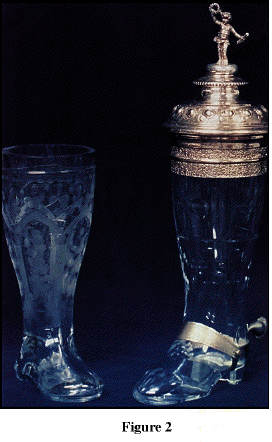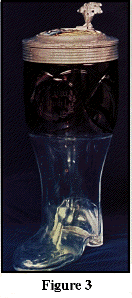|
Stein Collectors International, Inc. |
|
~ Give 'Em The Boot ~ by SCI Master Steinologist John Stuart |
 |
  In
the U.S., that means "throw the bum out," and if they don't leave
voluntarily, we will literally use our boot to kick them out. As in so
many
other traditions, the Germans have a different use - one that involves
beer. The
"Trinkenstiefel" is a drinking boot. These drinking boots were most
commonly made from glass and, to a lesser degree, stoneware or pottery. In
the U.S., that means "throw the bum out," and if they don't leave
voluntarily, we will literally use our boot to kick them out. As in so
many
other traditions, the Germans have a different use - one that involves
beer. The
"Trinkenstiefel" is a drinking boot. These drinking boots were most
commonly made from glass and, to a lesser degree, stoneware or pottery.The boots must be drunk from correctly or the drinker gets a face full of beer. If the toe of the boot is held straight up or straight down, once the boot is raised past a certain angle, beer will rush out dousing the drinker. The boot must be held on its side so the heel and toe are on the horizontal, parallel to the ground. (Life is always kinder when you know its little secrets.) Most drinking boots came from Germany, although some came from other countries. Falstaff, from England, was one of the seven legendary, drinkers of all time. He is frequently depicted sitting back in a big chair, his one foot up on a gout stool, drinking from one of his gigantic dirty leather boots. As far as I'm concerned, I think I would rather take my chances with the plague. Now crystal boots - they are another story . |
I have pictured four drinking boots from my collection. The first item Figure 1) is an elegant large two liter Crystal boot made by the WMF (Wurttembergisch Metal Iwarenfabrik) company. It has a fancy cut and polished geometric design. I walked into an antique show in Philadelphia and saw this in a case. Being a collector of glass steins and drinking vessels, I knew immediately that this piece was destined to reside on my shelves. After an eternity (about 90 seconds) the dealer pulled it out of the case. The lid was bent a little and the pewter eagle had some feathers missing. As I was assessing the condition I noticed some engraving (translated): "Reservist Boldt; 5th Company; Magdeburg Dragoon Regiment Number 6; Diedenhofen; Riding School, Hannover 1898-1901" on the strap over the instep. The lid was engraved: "Reservist Boldt; 1 Prize, Riding School, Hannover 1901." This scarce designation made the boot even more appealing. I was probably as nervous waiting to finalize this deal as Reservist Boldt was on the day he was waiting to receive his elegant first prize trophy. I'm sure he worked a lot harder than I did to earn it, but I love it just the same. The pair of boots in figure 2 each hold a half a liter. The one on the left is copper wheel etched with hops leaves and buds in five arched panels and a geometric border. The one on the right is cut with a hard wheel and then polished using a more simple geometric design. It has a silver-plated brass stirrup and spur, and a silver-plated set-on lid with a finial of Cupid with his olive leaf wreath and a handful of arrows. It was also made by WMF around 1890. WMF was the largest German pewter factory at the turn of the century. They also made electroplated wares in addition to their pewter work.  The last piece, Figure 3, is almost a boot stein. It doesn't have a handle but it does have a hinged-lid with a thumblift. Most boots have set-on lids. The top portion of the 3/4 liter boot is cut in a geometric design with a round center panel "To your Health." It is ruby stained after cutting. The pewter lid is signed "Johann Georg Winckler, Lindau," dating the piece to around 1875. The lid has a hand-painted porcelain inlay with a scene of a young lady poaching a rabbit from a hunter who is in the background. The hunter's dog has grabbed her underwear in his teeth while she is trying to escape across a stream. This exposed her bare bottom which was pretty risqué for the time. All in all, I really like the designs, the history and the uniqueness of these items. So if any of you want to give me the boot, as long as it is something like these pieces--go to it! |